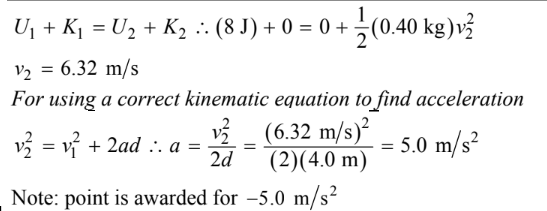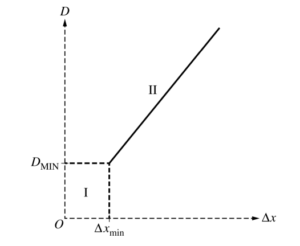Question
The variable x represents the position of particle A in a two-particle system. Particle B remains at rest. The above graph shows the potential energy U ( x) of the system as a function of position x of particle A, which has a mass of 0.40 kg. Particle A is released from rest at the position x = 2.0 m. Assume positive to be toward the right.
(a) Calculate the speed of particle A when it reaches position x = 14.0 m.
(b) i. Calculate the magnitude of the acceleration of particle A when it reaches position x= 3.0 m.
ii. What is the direction of the acceleration of particle A when it reaches position x= 3.0 m? Left Right
(c) Determine the magnitude of the acceleration of particle A when it reaches position x = 7.0 m.
(d) Particle A is again released from rest at the position x = 2.0 m.
i. Calculate the elapsed time for particle A to travel from position x = 2.0 m to position x = 6.0 m.
ii. Calculate the elapsed time for particle A to travel from position x = 6.0 m to position x = 8.0 m.
iii. Calculate the elapsed time for particle A to travel from position x = 8.0 m to position x = 14 m.
(e) Particle A is now placed at position x= 7.0 m. In order for particle A to reach the position x = 16.0 m and to be moving at a speed of 1.0 m s, what initial speed should particle A be given at its new initial position of x = 7.0 m?
(f) On the grid below, carefully draw a graph of the force F acting on particle A as a function of x for the range 0 < x < 16 m.

Answer/Explanation
(a) For correctly using conservation of energy \(U_1+K_1=U_2+K_2\) \(U_1+0=U_2+\frac{1}{2}mv^2\) For correctly substituting values from the graph into the equation above
\((8j)=(6j)+\left ( \frac{1}{2} \right )(0.40kg)v^2\)
\(v=3.16m/s\)
(b)
i) For correctly relating the slope of the line to the force exerted on the particle \(F=-slope=-\frac{(U_2-U_1)}{(X_2-X_1)}=-\frac{(12-0)J}{(0-6)M}=2.0N\)
For using Newton’s second law to calculate the acceleration of the particle \(a=\frac{F}{m}=\frac{(2.0N)}{(0.40kg)}=5.0/s^2\)
Note: point is awarded for \(5.0 m/ s^2\)
(b)
i) Alternate Solution
Solving for two velocities between 2.0 m and 6.0 m\( v_1 = 0\)

ii) For selecting answer consistent with part (b)(i)
(c) For a correct answer \(F=-slope=0\therefore a=0\) Note: credit is given even if no work is shown
(d)
i) For using a correct kinematic equation to calculate the time
\(d=v_1t+\frac{1}{2}at^2=0+\frac{1}{2}at^2\)
For correctly substituting acceleration from part (b)(i) into equation above
\(t=\sqrt{\frac{2d}{a}}=\frac{(2)(6.0-2.0)m}{(5.0m/s^2)}=1.26s\)
ii) For using a correct kinematic equation to determine the speed at x = 6.0 m or using the velocity at 6.0 m from alternate solutions part (b)(i) or (d)(i)
\(v^2_2=v^2_1+2ad=0+2ad
v_2=\sqrt{2ad}=\sqrt{(2)(5.0m/s^2)(6.0-2.0)m} v_{2}=6.32m/s
For using a kinematic equation for zero acceleration to calculate the time d =vt
\(t=\frac{d}{v}=\frac{(8.0-6.0)m}{(6.32m/s)}\) t=0.32s
Alternate Solution
For correctly using the energy equation to solve for the speed at 6.0 m (or using the value from alternate solution part (b)(i)
\(U_{1}+K_{1}=U_{2}+K_{2} \therefore (8J) +0+\frac{1}{2}(0.40kg)v^{2}_{2} v_{2}=6.32m/s\)
For using a kinematic equation with zero acceleration to calculate the time d=vt\( t=d/v=(8.0-6.0)m/(6.32m/s) t=0.32s\)
(d)
iii) For using a correct kinematic equation to calculate the time
\(d=\frac{1}{2}(v_1+v_2)t\)
\(t=\frac{2d}{(v_1+v_2)}=\frac{(2)(14-8.0)m}{(6.32m/s+3.16m/s)} t=1.26s\)
(e) For correctly using conservation of energy to calculate the speed
\(U_1+K_1=U_2+K_2\)
\(0+\frac{1}{2}m_1v^2_1\)
\(0+\frac{1}{2}m_1v^2_1=U_2+\frac{1}{2}m_2v^2_2\)
\(\left ( \frac{1}{2} \right )(0.40kg)v^2_1=(6j)+\left ( \frac{1}{2} \right )(0.40kg)(1.0m/s^2)
v=5.57m/s\)
(f) For a horizontal line at F = 2 N from x = 0 m to x = 6 m
For a horizontal line at F = 0 from x = 6 m to x = 8 m and from x = 14 m to x = 16 m
For a horizontal line at F = –1 N from x = 8 m to x = 14 m
Note: Two points earned if shape and magnitudes are correct but graph is inverted
Question

A student sets up an experiment with a cart on a level horizontal track. The cart is attached with an elastic cord to a force sensor that is fixed in place on the left end of the track. A motion sensor is at the right end of the track, as shown in the figure above. The cart is given an initial speed of v0 = 2.0 m s and moves with this constant speed until the elastic cord exerts a force on the cart. The motion of the cart is measured with the motion detector, and the force the elastic cord exerts on the cart is measured with the force sensor. Both sensors are set up so that the positive direction is to the left. The data recorded by both sensors are shown in the graphs of velocity as a function of time and force as a function of time below.

(a) Calculate the mass m of the cart. For time period from 0.50 s to 0.75 s, the force F the elastic cord exerts on the cart is given as a function of time t by the equation F A = sin(ωt) , where A = 6.3 N and ω = 12.6 rad/s.
(b) Using the given equation, show that the area under the graph above is 1.0 N .s
(c) The experiment is repeated using a different cord that exerts a larger average force on the cart. The cart starts and ends with the same speeds as those in the original experiment. Will the area for the graph of force as a function of time for the new cord be greater than, less than, or equal to the area for that of the original cord? ____ Greater than ____ Less than ____ Equal to Justify your answer. The elastic cord from the original experiment can be modeled as an ideal spring with force constant k .
(d) Derive an expression for the maximum change in length \(x_{MAX}\) for the cord. Express your answer in terms of m, k, \(v_0\) , and physical constants, as appropriate.
The student performs several trials of the experiment. For the first trial, the cart is empty. In each succeeding trial, a block is added to the cart. In all trials, the cart has an initial speed of 2.0 m s to the right, the cart rebounds to the left with a speed of 2.0 m s , and the maximum change in length of the elastic cord is measured. The total mass M of the cart and the maximum change in length of the cord in each trial are recorded in the table below.

(e) Indicate below which quantities should be graphed to yield a straight line with a slope that could be used to calculate a numerical value for the force constant of the elastic cord k. Vertical axis:
Horizontal axis: Use the remaining columns in the table on the previous page, as needed, to record any quantities that you indicated that are not given.
(f) Plot the data points for the quantities indicated in part (e) on the graph below. Clearly scale and label all axes, including units as appropriate. Draw a straight line that best represents the data.

(g) Use the best-fit line to calculate the force constant k of the elastic cord.
Answer/Explanation
(a) For correctly using the area under the graph to calculate the mass of the cart j=Area = \(\Delta p=m(v_2-V_1)\) For a correct answer with units \(m=\frac{Area}{(v_2-v_1)}\)=\(\frac{(1.0N.s)}{(2.0m/s-(-2.0m/s))}\) m = 0.25 kg
(b) For relating the time integral of given equation to the area under the curve For applying the correct limits of integration
\(j=Area=\int_{0.50}^{0.75}Asin(\omega t)dt\)
\(j=-\frac{A}{\omega }[cos\omega t]_{0.50}^{0.75}=-\frac{(6.3N)}{(12.6rad/s)}[cos(12.6t)]_{0.50}^{0.75}\)
\(j=-(0.50)(cos[12.6(0.75)])-cos[(12.6)(0.50)]\)
\(j=1.0N.s\)
(c) For selecting “Equal to” with an attempt at a relevant justification For a correct justification Example: Since the cart starts and ends at the same velocity, the impulse on the cart will be the same so the area under the graph will be the same. Note: If the wrong selection is made, the justification is ignored.
(d) For correctly using conservation of energy
\(U_{MAX}=K_{MAX}\)
\(\frac{1}{2}kx^{2}_{MAX}=\frac{1}{2}mv_{0}v^2\)
\(x_{MAX}=v_{0}\sqrt{\frac{m}{k}}\)
(e) For correctly indicating two variables that will yield a straight line that could be used to determine a value for Example: Vertical Axis: \(x_{MAX}\) Horizontal Axis:\(\sqrt{m}\)
Note: Student earns full credit if axes are reversed or if they use another acceptable combination
(f) For a correct scale that uses more than half the grid 1 point For correctly labeling the axis with variables and units consistent with part (e) Note: Student earns full credit if axes are reversed
For correctly plotting data For drawing a straight line consistent with the plotted data
(g) For correctly calculating the slope from the best-fit line and not the data points
Example: \(slope=\frac{\Delta x_{MAX}}{\Delta \sqrt{m}}=\frac{(0.40-0.20)m}{(1.32-0.70)\sqrt{kg}}=0.34m/\sqrt{kg} 0.33m/\sqrt{kg}\)
\(\frac{v_{0}}{\sqrt{k}}\therefore k=\frac{v^2_{0}}{(slope)^2}=\frac{(2.0m/s)^2}{(0.34m/\sqrt{kg})^2}\) k=34.6N/m
(linear reression k=36.7N/m)
Question

A block of mass m is placed on top of an ideal spring of spring constant k . The block is pushed against the spring, compressing the spring a distance ∆x. The block is released from rest, leaves the spring at the position shown in the figure, travels upward, and enters a track with a constant radius of curvature R that has negligible friction. The block enters the track at point A, maintains contact with the track, and exits horizontally at point B, a distance 3R above the point the block was released. The block then falls to the ground and lands a horizontal distance D from the end of the track. Express all algebraic answers in terms of m, k , , ∆x R, and physical constants, as appropriate. The size of the block is much smaller than the radius of curvature of the track.
(a) On the dot below, which represents the block, draw and label the forces (not components) that act on the block while still in contact with the track at point B. Each force must be represented by a distinct arrow starting on, and pointing away from, the dot.

Justify your choice of vectors.
(b)
i. Derive an expression for the speed v of the block at point B.
ii. Derive an expression for the magnitude of the net force F on the block at point B.
(c) Derive an expression for the minimum value of Δxmin required in order for the block to maintain contact with the track through point B. The procedure is repeated several times with the distance Δx > Δxmin.
(d) Calculate the distance D that the block travels.
(e) The graph below shows the best-fit line drawn by the students through their data of D as a function of Δx.

i. Explain why there are no data for section I of the graph.
ii. Explain the reason for the shape and minimum value of section II on the graph.
Answer/Explanation
Ans:
(a)

The force of gravity is includes because it always polls objects toward the earth (down). Depending on how fast the block is moving, it might also experience a normal force from the ramp. The normal force is always perpendicular to the surface, so it too points down
(b)
i.
E2 = E1
Kf + Uf = Usil
\(\frac{1}{2}mv^{2}+mgh = \frac{1}{2}ux^{2}\)
\(mv^{2}+2mg(3R)=k(\Delta x)^{2}\)
\(v = \sqrt{\frac{k(\Delta x^{2})-comgR}{m}}\)
ii.
\(F_{net}=\frac{mv^{2}}{R}\)
\(=\frac{m\left ( \frac{k(\Delta x)^{2}-6 mg R}{m} \right )}{R}\)
\(F = \frac{k(\Delta x)^{2}}{R}-6mg\)
(c)
\(F_{grav}=\frac{mv^{2}}{r}\)
\(mg=\frac{mv^{2}}{R}\)
\(v = \sqrt{gR}\)
\(\sqrt{gR}=\sqrt{\frac{k(\Delta x^{2})-6 mgR}{m}}\)
mgR = k(Δx)2 – 6mgR
7mgR = k(Δx)2
\(\Delta x_{min} = \sqrt{\frac{7mgR}{k}}\)
(d)
\(w/f_{f}=y_{1}+{v_{1}}^{t}+\frac{1}{2}at\)
\(0 = 3R – \frac{(g)}{2}t^{2}\)
\(\sqrt{\frac{6R}{g}}= t\)
xf = x1 + vt
D = v(t)
\(D = \sqrt{\frac{k(\Delta x)^{2}-6mgR}{m}}.\sqrt{\frac{6R}{g}}\)
\(D = \sqrt{\frac{6kR(\Delta x)^{2}-6mgR^{2}}{mg}}\)
(e)
i.
When Δx is less than Δxmin, the block does not maintain contact with the track until point B
ii.
D is directly proportional to the square root of (Δx)2, which means that D is proportional to Δx, this linear relationship produces a line.

